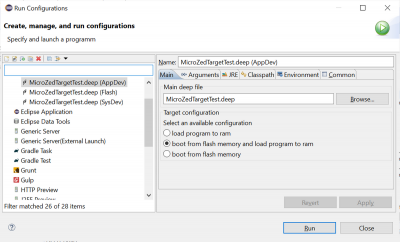Application Development
This is the preferred method when writing applications on the MicroZed board using the existing runtime library together with the board support package.
While you can load and test new custom applications quickly, the configuration of the FPGA is loaded from the QSPI flash. This saves time compared to using the method System Developer.
Step by Step Instructions
- Make sure that you have a suitable boot loader in your QSPI flash, see Boot Loader. This must be done only once as long as you don't overwrite it.
- Cycle the power. The settings of the jumpers will be read only at power-on! Hence, make sure to cycle the supply power after changing the jumper settings. A soft reset (through the JTAG or by pressing the reset button on the board will reset the board but will not sample the boot mode pins connected to the jumpers.
- Create a deep project and setup the project configuration as given in Hello World on the Avnet MicroZed Board. Make sure that you have set the OpenOCD command and command options so that it suits your installation, please refer to Setting Deep Preferences.
- Run will compile, link and download the image file. See Hello World on the Avnet MicroZed Board for guidance about necessary installations and properly connecting the target.
How Does the System Boot?
- reset (by JTAG)
- load and run first stage boot loader from flash
- configuration of PLL, clocks, DDR
- load PL
- handoff to JTAG
- halt
- reset REBOOT_STATUS register
- download of bin-files to OCM and DDR
- download of bit-file (if specified)
- start at address 0x100


